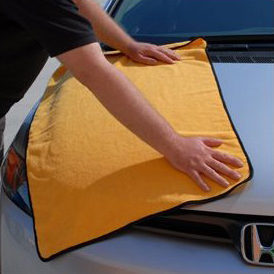Before we get started talking about drying your car, refer to the tools required to dry your car for product suggestions.
Proper Techniques When Drying a Car
Why do I need to dry my car?
Drying your car prevents water spots forming on the surface, these spots are caused by mineral deposits in water that etch on the surface of the paint as water evaporates. Water spots when left on the surface whether on your car’s paint or windows can be very difficult to remove and may require compounding and polishing to remove.
 There are several ways in drying a car
There are several ways in drying a car
Flooding method – remove the nozzle attached to your hose then use running water on the car’s surface allowing water to sheet off the paint removing majority of the water. Dry excess water with a microfiber towel.
If you’re using a water blade, you would still need a microfiber towel to remove the rest of the water. Make sure your car’s surface is free from any dust or debris that can be dragged by the water blade and scratch the paint.
For drying tight crevices on your vehicle, the Metro Vac N Blo will help you dry those hard to reach areas that your microfiber towel won’t be able to dry off.
Tips for Drying your car
- Start drying the mirrors first to prevent water spots from forming.
- Remove the excess water on the vehicle with a microfiber towel. For hard to reach crevices you can use the Metro Vac N Blo to blow off excess water. This process can help you dry your car in a relatively quick time.
- Once you finish drying the outside don’t forget to wipe down all door jambs, including the hood and the trunk.
- When drying your wheels and tires, use a separate microfiber towel or chamios to avoid contaminating the other parts of the vehicle.
Finishing Touches
Use a Quick Detailer or Spray Sealant to rejuvenate the shine on your car’s paint. If you’re waxing your car skip this step.
You can save some time by misting the entire car with a quick detailer or spray sealant before wiping it dry as shown in the video below.
What’s Next?